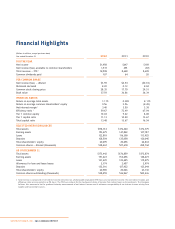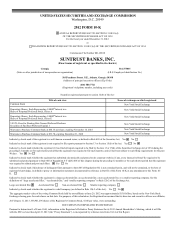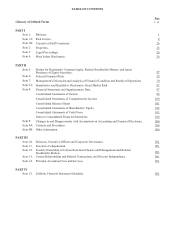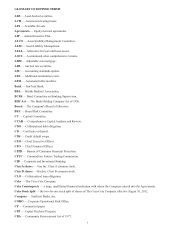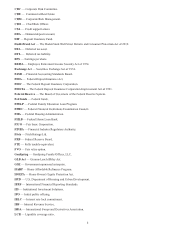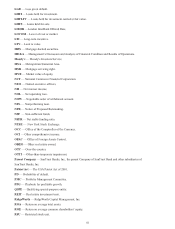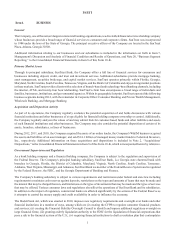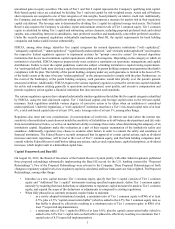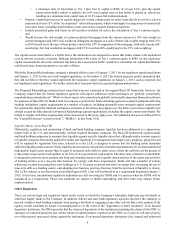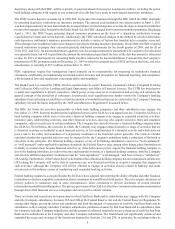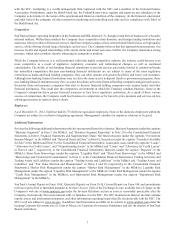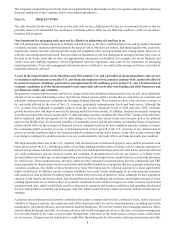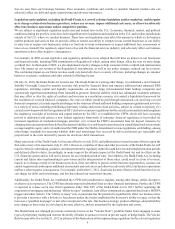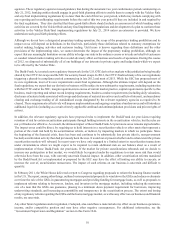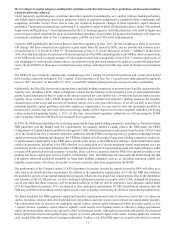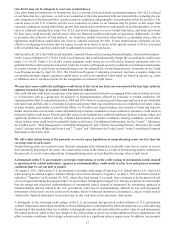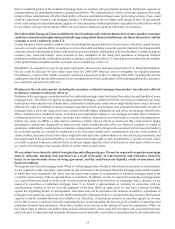SunTrust 2012 Annual Report Download - page 20
Download and view the complete annual report
Please find page 20 of the 2012 SunTrust annual report below. You can navigate through the pages in the report by either clicking on the pages listed below, or by using the keyword search tool below to find specific information within the annual report.
4
a minimum ratio of Total (that is, Tier 1 plus Tier 2) capital to RWA of at least 8.0%, plus the capital
conservation buffer (which is added to the 8.0% total capital ratio as that buffer is phased in, effectively
resulting in a minimum total capital ratio of 10.5% upon full implementation);
• Propose a significant increase to capital charges for certain commercial real estate loans that do not involve a down
payment of at least 15% of the “as completed” value of the property, which would apply to a large array of commercial
real estate loans, including small business loans and owner-occupied business properties;
• Include unrealized gains and losses on all securities available for sale in the calculation of Tier 1 common equity;
and
• Would increase the risk-weights of certain residential mortgages from the current system of a 50% risk-weight on
current mortgages and 100% risk-weight on delinquent mortgages to a scale of these risk-weights ranging from 35%
to 200% based on (i) the type of loan product and (ii) the LTV at origination of the mortgage, with only current, full-
amortizing, first lien residential mortgages with LTVs less than 60% qualifying for the 35% risk-weighting.
The capital conservation buffer is a buffer above the minimum levels designed to ensure that banks remain well-capitalized
even in adverse economic scenarios. Banking institutions with a ratio of Tier 1 common equity to RWA (or any regulatory
capital measurement) above the minimum but below the conservation buffer would face constraints on capital distributions
and discretionary bonus payments to executive officers.
While the Proposed Rulemakings contained a planned effective date of January 1, 2013 for the regulatory capital regulations
and January 1, 2015 for the asset risk-weight regulations, on November 9, 2012 the federal agencies jointly announced that
they did not believe that they would implement the regulatory capital regulations on January 1, 2013, and as expected, did
not implement such regulations. No further details have been provided on expected implementation dates.
The Proposed Rulemakings contained new items that were not contained in the original Basel III framework; however, the
Company expects that the federal regulatory agencies will impose additional capital surcharges on “globally systemically
important financial institutions”. While we do not expect to be considered a globally systemically important financial institution
for purposes of Basel III, the Dodd-Frank Act requires or permits the Federal banking agencies to adopt regulations affecting
banking institutions' capital requirements in a number of respects, including potentially more stringent capital requirements
for systemically important financial institutions, and some or all of these may apply to us. We believe our current capital levels
already exceed the fully phased-in Proposed Rulemakings capital requirements, including the capital conservation buffer. We
intend to comply with those requirements when announced as they may apply to us. See additional discussion of Basel III in
the "Capital Resources" section in Item 7, "MD&A", in this Form 10-K.
Liquidity Ratios under Basel III
Historically, regulation and monitoring of bank and bank holding company liquidity has been addressed as a supervisory
matter, both in the U.S. and internationally, without required formulaic measures. The Basel III framework requires banks
and bank holding companies to measure their liquidity against specific liquidity ratios that, although similar in some respects
to liquidity measures historically applied by banks and regulators for management and supervisory purposes, going forward
will be required by regulation. One ratio, referred to as the LCR, is designed to ensure that the banking entity maintains
sufficient liquidity under an acute 30-day liquidity stress scenario. Specifically, the bank must maintain a level of unencumbered
high-quality liquid assets greater than or equal to projected cash outflows under stress, where the outflows are the greater of
(i) the entity's expected net cash outflow or (ii) 25% of its expected total cash outflow. The other ratio, referred to as the NSFR,
is designed to promote more medium and long-term funding based on the liquidity characteristics of the assets and activities
of banking entities over a one-year time horizon. To comply with these requirements, banks will take a number of actions
which may include increasing their asset holdings of U.S. Treasury securities and other sovereign debt, increasing the use of
long-term debt as a funding source, and adopting new business practices that may limit the provision of liquidity to clients.
The LCR is subject to an observation period that began in 2011, but will be phased-in as a requirement beginning January 1,
2015. At this time, international regulatory authorities are still assessing the NSFR and it is unclear when the NSFR will be
introduced as a requirement. These new standards are subject to further rulemaking, and their terms may change before
implementation.
Other Regulation
There are various legal and regulatory limits on the extent to which the Company's subsidiary bank may pay dividends or
otherwise supply funds to the Company. In addition, federal and state bank regulatory agencies also have the authority to
prevent a bank or bank holding company from paying a dividend or engaging in any other activity that, in the opinion of the
agency, would constitute an unsafe or unsound practice. In the event of the “liquidation or other resolution” of an insured
depository institution, the FDIA provides that the claims of depositors of the institution (including the claims of the FDIC as
subrogee of insured depositors) and certain claims for administrative expenses of the FDIC as a receiver will have priority
over other general unsecured claims against the institution. If an insured depository institution fails, insured and uninsured


